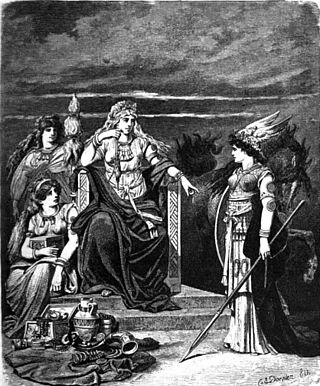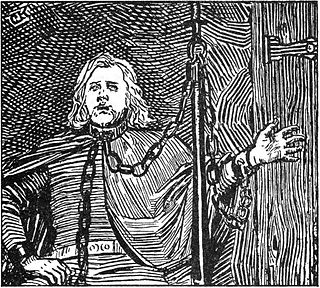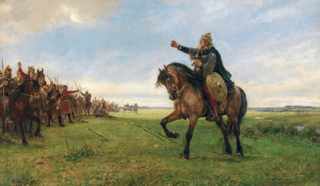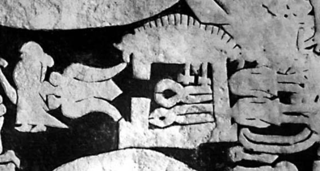Related Research Articles

Poetry, also called verse, is a form of literature that uses aesthetic and often rhythmic qualities of language − such as phonaesthetics, sound symbolism, and metre − to evoke meanings in addition to, or in place of, a prosaic ostensible meaning. A poem is a literary composition, written by a poet, using this principle.
Prose is the form of written language that follows the natural flow of speech, a language's ordinary grammatical structures, or typical writing conventions and formatting. It differs from traditional poetry, where the format consists of verse: writing in lines that follow rhythmic metre or a rhyme scheme. The word "prose" first appears in English in the 14th century. It is derived from the Old French prose, which in turn originates in the Latin expression prosa oratio.

In Norse mythology, Hlín is a goddess associated with the goddess Frigg. Hlín appears in a poem in the Poetic Edda, compiled in the 13th century from earlier traditional sources, the Prose Edda, written in the 13th century by Snorri Sturluson, and in kennings found in skaldic poetry. Scholars have debated whether the stanza referring to her in the Prose Edda refers to Frigg. Hlín serves as a given name in Iceland, and Hlín receives veneration in the modern era in Germanic paganism's modern extension, Heathenry.

In Norse mythology, Fensalir is a location where the goddess Frigg dwells. Fensalir is attested in the Poetic Edda, compiled in the 13th century from earlier traditional sources, and the Prose Edda, written in the 13th century by Snorri Sturluson. Scholars have proposed theories about the implications of the location, including that the location may have some connection to religious practices involving springs, bogs, or swamps in Norse paganism, and that it may be connected to the goddess Sága's watery location Sökkvabekkr.

A skald, or skáld is one of the often named poets who composed skaldic poetry, one of the two kinds of Old Norse poetry in alliterative verse, the other being Eddic poetry. Skaldic poems were traditionally composed to honor kings, but were sometimes extempore. They include both extended works and single verses (lausavísur). They are characteristically more ornate in form and diction than eddic poems, employing many kennings, which require some knowledge of Norse mythology, and heiti, which are formal nouns used in place of more prosaic synonyms. Dróttkvætt metre is a type of skaldic verse form that most often use internal rhyme and alliteration.
Sagas are prose stories and histories, composed in Iceland and to a lesser extent elsewhere in Scandinavia.
The genre of Menippean satire is a form of satire, usually in prose, that is characterized by attacking mental attitudes rather than specific individuals or entities. It has been broadly described as a mixture of allegory, picaresque narrative, and satirical commentary. Other features found in Menippean satire are different forms of parody and mythological burlesque, a critique of the myths inherited from traditional culture, a rhapsodic nature, a fragmented narrative, the combination of many different targets, and the rapid moving between styles and points of view.

Old Norse religion, also known as Norse paganism, is a branch of Germanic religion which developed during the Proto-Norse period, when the North Germanic peoples separated into a distinct branch of the Germanic peoples. It was replaced by Christianity and forgotten during the Christianisation of Scandinavia. Scholars reconstruct aspects of North Germanic Religion by historical linguistics, archaeology, toponymy, and records left by North Germanic peoples, such as runic inscriptions in the Younger Futhark, a distinctly North Germanic extension of the runic alphabet. Numerous Old Norse works dated to the 13th-century record Norse mythology, a component of North Germanic religion.

Hervarar saga ok Heiðreks is a legendary saga from the 13th century combining matter from several older sagas in Germanic heroic legend. It tells of wars between the Goths and the Huns during the 4th century. The final part of the saga, which was likely composed separately from and later than the rest, is a source for Swedish medieval history.

Vǫlundarkviða is one of the mythological poems of the Poetic Edda. The title is anglicized in various ways, including Völundarkvitha, Völundarkvidha, Völundarkvida, Volundarkvitha, Volundarkvidha and Volundarkvida.

Sigvatr Þórðarson or Sighvatr Þórðarson or Sigvat the Skald (995–1045) was an Icelandic skald. He was a court poet to King Olaf II of Norway, as well as Canute the Great, Magnus the Good and Anund Jacob, by whose reigns his floruit can be dated to the earlier eleventh century. Sigvatr was the best known of the court skalds of King Olaf and also served as his marshal (stallare), even baptizing his son Magnus.
In Norse mythology, Mótsognir, also found as Móðsognir, "he who drinks in courage", is the ruler of the dwarves. In Völuspà 10, he is identified as mæztr um orðinn dverga allra, "lord of all the dwarves". According to Snorri Sturluson in Gylfaginning 14, which seeks to explain this verse, "the dwarfs had taken shape first and acquired life in the flesh of Ymir and were then maggots, but by decision of the gods they became conscious with intelligence and had the shape of men though they live in the earth and in rocks. Modsognir was a dwarf and the second was Durinn."

Cosmographia ("Cosmography"), also known as De mundi universitate, is a Latin philosophical allegory, dealing with the creation of the universe, by the twelfth-century author Bernardus Silvestris. In form, it is a prosimetrum, in which passages of prose alternate with verse passages in various classical meters. The philosophical basis of the work is the Platonism of contemporary philosophers associated with the cathedral school of Chartres—one of whom, Thierry of Chartres, is the dedicatee of the work. According to a marginal note in one early manuscript, the Cosmographia was recited before Pope Eugene III when he was traveling in France (1147–48).
Ernst Peter Michael Dronke FBA was a scholar specialising in Medieval Latin literature. He was one of the 20th century's leading scholars of medieval Latin lyric, and his book The Medieval Lyric (1968) is considered the standard introduction to the subject.
Ursula Miriam Dronke was an English medievalist and former Vigfússon Reader in Old Norse at the University of Oxford and an Emeritus Fellow of Linacre College. She also taught at the University of Munich and in the Faculty of Modern and Medieval Languages at Cambridge University.

Germanic heroic legend is the heroic literary tradition of the Germanic-speaking peoples, most of which originates or is set in the Migration Period. Stories from this time period, to which others were added later, were transmitted orally, traveled widely among the Germanic speaking peoples, and were known in many variants. These legends typically reworked historical events or personages in the manner of oral poetry, forming a heroic age. Heroes in these legends often display a heroic ethos emphasizing honor, glory, and loyalty above other concerns. Like Germanic mythology, heroic legend is a genre of Germanic folklore.
Wolfhart P. Heinrichs was a German-born scholar of Arabic. He was James Richard Jewett Professor of Arabic at Harvard University, and a co-editor of the second edition of the Encyclopaedia of Islam. He taught Classical Arabic language and literature, particularly Arabic literary theory and criticism.
In Norse mythology, the sister-wife of Njörðr is the unnamed wife and sister of the god Njörðr, with whom he is described as having had the twin children Freyr and Freyja. This shadowy goddess is attested to in the Poetic Edda poem Lokasenna, recorded in the 13th century by an unknown source, and the Heimskringla book Ynglinga saga, a euhemerized account of the Norse gods composed by Snorri Sturluson also in the 13th century but based on earlier traditional material. The figure receives no further mention in Old Norse texts.
The Old English Boethius is an Old English translation/adaptation of the sixth-century Consolation of Philosophy by Boethius, dating from between c. 880 and 950. Boethius's work is prosimetrical, alternating between prose and verse, and one of the two surviving manuscripts of the Old English translation renders the poems as Old English alliterative verse: these verse translations are known as the Metres of Boethius.
Heather O'Donoghue is a British academic. She is Professor of Old Norse and Vigfusson Rausing Reader in Ancient Icelandic Literature and Antiquities at the University of Oxford. She is a Fellow of Linacre College, Oxford.
References
- ↑ Braund, Susanna. "Prosimetrum". In Cancil, Hubert, and Helmuth Schneider, eds. Brill's New Pauly. Brill Online, 2012. Retrieved 2 October 2015.
- 1 2 3 4 5 6 7 8 Brogan, T.V.F. "Prosimetrum". In Green et al., pp. 1115–1116.
- ↑ Harris & Reichl, p. 11.
- ↑ Hanson, Kristin, and Paul Kiparsky. "The Nature of Verse and Its Consequences for the Mixed Form". In Harris & Reichl, p. 36.
- 1 2 Dronke, p. 2.
- ↑ Ricklin, Thomas. "Femmes-philosophie et hommes-animaux: essai d'une lecture satirique de la Consolatio philosophiae de Boèce". In Boèce ou la chaîne des savoirs: actes du Colloque international de la Fondation Singer-Polignac, Paris, 8–12 juin 1999. Louvain: Peeters, 2003. p. 131. ISBN 90-429-1250-2
- ↑ Ziolkowski, Jan. "The Prosimetrum in the Classical Tradition," in Harris & Reichl, p. 48.
- ↑ Ziolkowski, pp. 55–56.
- ↑ Ross, pp. 80–81.
- ↑ Þorgeirsdóttir, Brynja; Gropper, Stefanie; Quinn, Judy; Wills, Tarrin; Wilson, Alexander (2022). "Investigating the Íslendingasögur as Prosimetrum: A New Methodology". Viking and Medieval Scandinavia. 18: 51–82. doi:10.1484/J.VMS.5.132122.
- 1 2 Mac Cana, Proinsias. "Prosimetrum in Insular Celtic Literature." In Harris & Reichl, pp. 110–111.
- ↑ O’Donoghue, pp 11–12.
- ↑ Qian, Ailin (2012). The Maqāmah as Prosimetrum: A Comparative Investigation of Its Origin, Form and Function (PhD). University of Pennsylvania. CiteSeerX 10.1.1.475.6202 .
- ↑ Heinrichs, Wolfhart. "Prosimetrical Genres in Classical Arabic Literature". In Harris & Reichl, p. 249.
- ↑ Jones, Jones, and Knight, p. 87.
- ↑ Mac Cana, p. 115.
- ↑ Heissig, Walther (1996). "The Present State of the Mongolian Epic and Some Topics for Future Research" (PDF). Oral Tradition. 11 (1): 89.
- ↑ O’Donoghue p. 101.
- ↑ O’Donoghue, pp. 181–182.
- ↑ Green et al., p. 1510.
- ↑ Harris & Reichl, p. 14.
- ↑ Alexis, André. Beauty and Sadness. Toronto: House of Anansi, 2010. p. 157. ISBN 978-0-88784-750-9